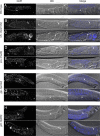A "latent niche" mechanism for tumor initiation
- PMID: 19564624
- PMCID: PMC2710656
- DOI: 10.1073/pnas.0903768106
A "latent niche" mechanism for tumor initiation
Abstract
Stem cells, their niches, and their relationship to cancer are under intense investigation. Because tumors and metastases acquire self-renewing capacity, mechanisms for their establishment may involve cell-cell interactions similar to those between stem cells and stem cell niches. On the basis of our studies in Caenorhabditis elegans, we introduce the concept of a "latent niche" as a differentiated cell type that does not normally contact stem cells nor act as a niche but that can, under certain conditions, promote the ectopic self-renewal, proliferation, or survival of competent cells that it inappropriately contacts. Here, we show that ectopic germ-line stem cell proliferation in C. elegans is driven by a latent niche mechanism and that the molecular basis for this mechanism is inappropriate Notch activation. Furthermore, we show that continuous Notch signaling is required to maintain ectopic germ-line proliferation. We highlight the latent niche concept by distinguishing it from a normal stem cell niche, a premetastatic niche and an ectopic niche. One of the important distinguishing features of this mechanism for tumor initiation is that it could operate in the absence of genetic changes to the tumor cell or the tumor-promoting cell. We propose that a latent niche mechanism may underlie tumorigenesis and metastasis in humans.
Conflict of interest statement
The authors declare no conflict of interest.
Figures



References
-
- Kimble J, Crittenden SL. Controls of germline stem cells, entry into meiosis, and the sperm/oocyte decision in Caenorhabditis elegans. Annu Rev Cell Dev Biol. 2007;23:405–433. - PubMed
-
- Hansen D, Schedl T. The regulatory network controlling the proliferation-meiotic entry decision in the Caenorhabditis elegans germ line. Curr Top Dev Biol. 2006;76:185–215. - PubMed
-
- Lambie EJ, Kimble J. Two homologous regulatory genes, lin-12 and glp-1, have overlapping functions. Development. 1991;112:231–240. - PubMed
-
- Henderson S, Gao D, Lambie E, Kimble J. lag-2 may encode a signaling ligand for the GLP-1 and LIN-12 receptors of C. elegans. Development. 1994;120:2913–2924. - PubMed
Publication types
MeSH terms
Substances
Grants and funding
LinkOut - more resources
Full Text Sources
Other Literature Sources

